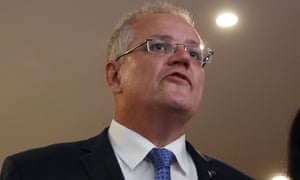Extract from The Guardian
Another climate announcement comes as the Coalition attempts to win back concerned voters
The Morrison government will persist with its attempted climate
policy pivot by promising $50m in grants for businesses and community
organisations to embark on energy efficiency projects, and an additional
$17m to help building owners benchmark their energy use.
The proposed investment in energy efficiency, which is one of the components of the government’s strategy for meeting Australia’s Paris commitments, comes as the prime minister has sent a public signal that Victorian energy retailers will have to pick up the costs of electricity transmitted through a second interconnector between Tasmania and the mainland.
As part of the government’s efforts to woo back voters in its small “l” liberal heartland deeply concerned about the Coalition’s record on climate change, Morrison has this week kicked in $56m for the Marinus link, and has flagged further taxpayer underwriting of the “battery of the nation” renewable energy project.
But asked by reporters how the total costs of the proposed
interconnector would be met, given the feasibility study for Marinus
link puts those costs between $1bn and $3bn, and also makes it clear the
“largest single influencing factor in the economic feasibility and
timing of [the project] is the trajectory of coal-fired generation
retirement”, the prime minister said: “It’d be a commercial project and a
commercial project means it can support its finance.The proposed investment in energy efficiency, which is one of the components of the government’s strategy for meeting Australia’s Paris commitments, comes as the prime minister has sent a public signal that Victorian energy retailers will have to pick up the costs of electricity transmitted through a second interconnector between Tasmania and the mainland.
As part of the government’s efforts to woo back voters in its small “l” liberal heartland deeply concerned about the Coalition’s record on climate change, Morrison has this week kicked in $56m for the Marinus link, and has flagged further taxpayer underwriting of the “battery of the nation” renewable energy project.
“So what does that mean when I say it’s on a commercial basis? It means it can pay for itself. It means it can actually generate the revenues that actually support its financing.”
Under the normal regulatory arrangements for transmission infrastructure, the costs would be apportioned between the two jurisdictions, but Tasmania is unhappy with that arrangement.
The Victorian minister for energy, environment and climate change, Lily D’Ambrosio, said the Morrison government had failed to provide national leadership on climate change “and in the absence of any federal leadership, we’re taking nation-leading action to address it”.
She said Victoria was pressing ahead with a commitment to net zero emissions by 2050 and increasing the state renewable energy target to 50% by 2030.
The federal government’s decision this week to greenlight the long-mooted Snowy Hydro expansion, and flag taxpayer underwriting for the Tasmanian proposals, has perturbed energy executives, heightening concerns that the government is again extemporising on energy policy.
There are concerns about the high costs of the projects, plus the associated transmission infrastructure, and also fears the two large developments will crowd out worthy smaller renewables and gas peaking projects.
As well as the significant industry concerns, environmental groups and climate policy experts have panned the government’s decision to resurrect Tony Abbott’s emissions reduction fund, give it a new name and a $2bn budget over 10 years – pointing out that the fund cannot do the heavy lifting on emissions reduction required to meet the Paris target.
The government this week specified various components of an abatement plan consistent with Australia meeting the 2030 target.
To meet the target, the government intends to count a 367 megatonne abatement from carry-over credits, which is not practical emissions reduction but an accounting system that allows countries to count carbon credits from exceeding their targets under the soon-to-be-obsolete Kyoto protocol periods against their Paris commitment for 2030.
It is also factoring in emissions reduction from the Snowy 2.0 expansion; energy efficiency measures; an electric vehicle strategy for which there are no details; the rebadged climate solutions fund; additional hydro projects and just under 100Mt of abatement from unspecified “technology solutions” and “other sources of abatement” such as projects under development but not yet contracted.
The new grants for energy efficiency to be unveiled on Thursday are part of the government’s roadmap. The energy minister, Angus Taylor, will allocate $50m for 2,500 grants to eligible businesses and community organisations to help them save energy by either installing new equipment or by reviewing and improving their energy management.
Eligible small businesses will be able to claim grants of up to $20,000, high-energy using businesses up to $25,000 and community groups up to $12,500.
Taylor said the energy efficiency measures would deliver an abatement of 63Mt of carbon, and promoting efficient energy usage is an important part of meeting the Paris target and lowering energy costs.

No comments:
Post a Comment